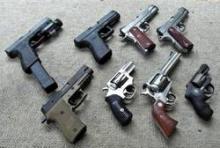SAN FRANCISCO – Deaths from gunshot wounds doubled between 2000 and 2012 in the region served by one New Jersey trauma center and gun-related homicides as a proportion of violent crimes increased by 27% in southern Arizona after the state stopped requiring permits for concealed weapons, separate studies found.
In 2000, 8% of patients treated for gunshot wounds died. That rate increased to 15% in 2011, according to a retrospective study of 6,323 gunshot wounds seen at the New Jersey Trauma Center, a Level I trauma center in Newark. The proportion of 15-minute time increments in which the hospital was treating two or more patients for gunshot wounds increased from approximately 10% in 2000 to nearly 30% by the end of 2011, and the proportion of 15-minute increments in which three or more gunshot wounds were being treated increased from 1% to 16%, reported Dr. David H. Livingston and his associates.
function runABTest(_videoIDs) { var rand = Math.floor(Math.random() * _videoIDs.length); return _videoIDs[rand]; } function delvePlayerCallback(playerId, eventName, data) { if (eventName == 'onPlayerLoad') DelvePlayer.doLoadMedia(runABTest(['7e6bb37a8a774e16a614e6fe8c00a0e2','ecc8cb17fd22411b9c6ffc44a986a590'])); } LimelightPlayerUtil.initEmbed('limelight_player_156792');
Surgery on 71% of these patients plus other services incurred $115 million in costs, 75% of it unreimbursed. The mean cost per patient increased by 282% during the study period, reported Dr. Livingston of University Hospital, Newark, N.J., and a professor of surgery at Rutgers University, also in Newark.
"I think nationally this could be billions of dollars," perhaps double that, if these conservative estimates are extrapolated, he said at the annual meeting of the American Association for the Surgery of Trauma.
The drain on trauma center resources is enormous, he said. Half of the patients in his study needed ICU care, a third needed a ventilator, and just less than a third needed blood transfusions. All of these parameters increased by 50% to 180% during the study period.
The search for data produced a surprise relying solely on trauma registries for data on gunshot wounds and deaths would have missed one out of every five cases because 19% of patients were treated in the emergency department (ED) and sometimes admitted to services other than the trauma unit, he said. The study tapped not only the trauma registry but also ED billing records and the hospital’s financial records.
Further, there was a doubling of both the proportion of cases with three or more gunshot wounds (from 10% to 20%) and the proportion of cases with three or more body areas that had been shot (from 5% to 10%).
Data suggest that gun violence in New Jersey is geographically restricted and not random, he said. Five cities in the state accounted for 85% of gunshot wounds (Newark, Irvington, East Orange, Orange, and Elizabeth); 75% of patients were shot in the city in which they lived, 55% within a mile of home, 25% within a block of home, and 15% in their homes. Half of gunshot wounds occurred in 15% of the region by Census tract.
The New Jersey study included only interpersonal gunshot injuries, not self-inflicted wounds or shots from police. Patients in that study were predominantly young, black men who had been shot with a handgun. The mean age was 27 years, and 98% of cases involved a handgun. The cohort was 86% black, 9% Hispanic, 4% white, and 1% Asian. "This demographic is different than the demographic of our catchment area," Dr. Livingston noted.
A separate study compared gun-related injury and deaths in the 2 years before and the 2 years after July 2010, when Arizona made it legal in that state to carry a concealed weapon without a permit or training. The proportion of homicides related to guns in southern Arizona increased significantly from 1.97% to 2.45% after that law was passed and deaths by firearms increased by 24% among victims of violent crimes and accidents, Dr. Rashna F. Ginwalla and her associates reported in a separate presentation.
The number of violent crimes and accidents stayed relatively stable, but the risk of any gun-related injury or death increased significantly by 11% after concealed-weapons regulations were eliminated, said Dr. Ginwalla, who led the study while at the University of Arizona, Tucson. Dr. Ginwalla now works in Rwanda for the University of Virginia, Charlottesville.
During the study period, Arizonans were more likely than was the general U.S. population to undergo a background check during a gun purchase, which the researchers used as a proxy for gun ownership. The study used data from the National Instant Criminal Background Check system, the trauma registry of the University of Arizona Medical Center (the only Level I trauma center for southern Arizona), the Pima County Medical Examiner’s Office, and the Tucson Police Department.


